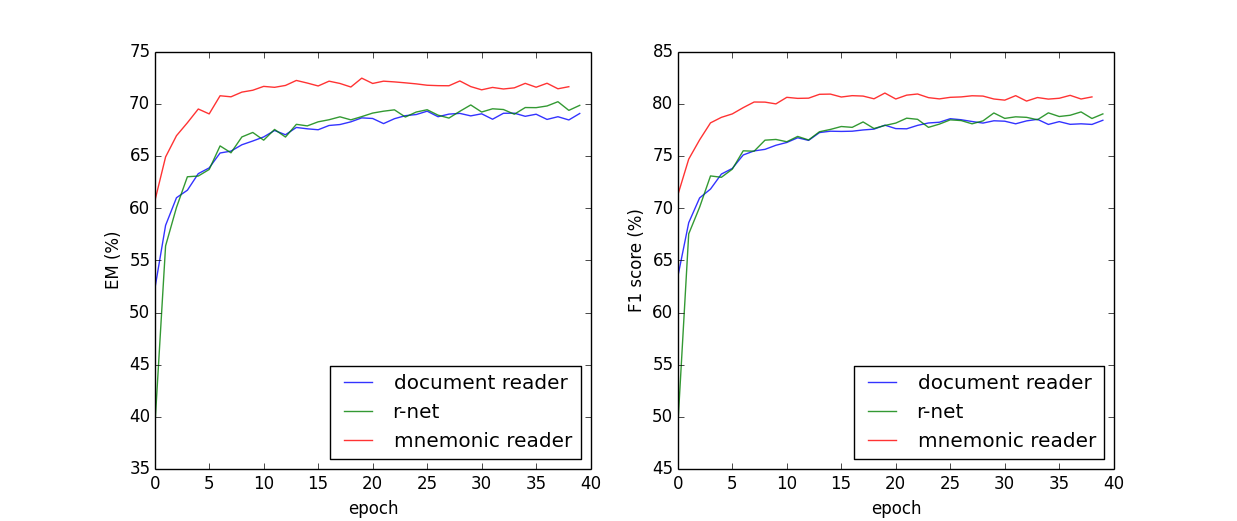HKUST-KnowComp / Mnemonicreader
Programming Languages
Projects that are alternatives of or similar to Mnemonicreader
Mnemonic Reader
The Mnemonic Reader is a deep learning model for Machine Comprehension task. You can get details from this paper. It combines advantages of match-LSTM, R-Net and Document Reader and utilizes a new unit, the Semantic Fusion Unit (SFU), to achieve state-of-the-art results (at that time).
This model is a PyTorch implementation of Mnemonic Reader. At the same time, a PyTorch implementation of R-Net and a PyTorch implementation of Document Reader are also included to compare with the Mnemonic Reader. Pretrained models are also available in release.
This repo belongs to HKUST-KnowComp and is under the BSD LICENSE.
Some codes are implemented based on DrQA.
Please feel free to contact with Xin Liu ([email protected]) if you have any question about this repo.
Evaluation on SQuAD
| Model | DEV_EM | DEV_F1 |
|---|---|---|
| Document Reader (original paper) | 69.5 | 78.8 |
| Document Reader (trained model) | 69.4 | 78.6 |
| R-Net (original paper 1) | 71.1 | 79.5 |
| R-Net (original paper 2) | 72.3 | 80.6 |
| R-Net (trained model) | 70.2 | 79.4 |
| Mnemonic Reader (original paper) | 71.8 | 81.2 |
| Mnemonic Reader + RL (original paper) | 72.1 | 81.6 |
| Mnemonic Reader (trained model) | 73.2 | 81.5 |
Requirements
- Python >= 3.4
- PyTorch >= 0.31
- spaCy >= 2.0.0
- tqdm
- ujson
- numpy
- prettytable
Prepare
First of all, you need to download the dataset and pre-trained word vectors.
mkdir -p data/datasets
wget https://rajpurkar.github.io/SQuAD-explorer/dataset/train-v1.1.json -O data/datasets/SQuAD-train-v1.1.json
wget https://rajpurkar.github.io/SQuAD-explorer/dataset/dev-v1.1.json -O data/datasets/SQuAD-dev-v1.1.json
mkdir -p data/embeddings
wget http://nlp.stanford.edu/data/glove.840B.300d.zip -O data/embeddings/glove.840B.300d.zip
cd data/embeddings
unzip glove.840B.300d.zip
Then, you need to preprocess these data.
python script/preprocess.py data/datasets data/datasets --split SQuAD-train-v1.1
python script/preprocess.py data/datasets data/datasets --split SQuAD-dev-v1.1
If you want to use multicores to speed up, you could add --num-workers 4 in commands.
Train
There are some parameters to set but default values are ready. If you are not interested in tuning parameters, you can use default values. Just run:
python script/train.py
After several hours, you will get the model in data/models/, e.g. 20180416-acc9d06d.mdl and you can see the log file in data/models/, e.g. 20180416-acc9d06d.txt.
Predict
To evaluate the model you get, you should complete this part.
python script/predict.py --model data/models/20180416-acc9d06d.mdl
You need to change the model name in the command above.
You will not get results directly but to use the official evaluate-v1.1.py in data/script.
python script/evaluate-v1.1.py data/predict/SQuAD-dev-v1.1-20180416-acc9d06d.preds data/datasets/SQuAD-dev-v1.1.json
Interactivate
In order to help those who are interested in QA systems, script/interactivate.py provides an easy but good demo.
python script/interactivate.py --model data/models/20180416-acc9d06d.mdl
Then you will drop into an interactive session. It looks like:
* Interactive Module *
* Repo: Mnemonic Reader (https://github.com/HKUST-KnowComp/MnemonicReader)
* Implement based on Facebook's DrQA
>>> process(document, question, candidates=None, top_n=1)
>>> usage()
>>> text="Architecturally, the school has a Catholic character. Atop the Main Building's gold dome is a golden statue of the Virgin Mary. Immediately in front of the Main Building and facing it, is a copper statue of Christ with arms upraised with the legend \"Venite Ad Me Omnes\". Next to the Main Building is the Basilica of the Sacred Heart. Immediately behind the basilica is the Grotto, a Marian place of prayer and reflection. It is a replica of the grotto at Lourdes, France where the Virgin Mary reputedly appeared to Saint Bernadette Soubirous in 1858. At the end of the main drive (and in a direct line that connects through 3 statues and the Gold Dome), is a simple, modern stone statue of Mary."
>>> question = "To whom did the Virgin Mary allegedly appear in 1858 in Lourdes France?"
>>> process(text, question)
+------+----------------------------+-----------+
| Rank | Span | Score |
+------+----------------------------+-----------+
| 1 | Saint Bernadette Soubirous | 0.9875301 |
+------+----------------------------+-----------+
More parameters
If you want to tune parameters to achieve a higher score, you can get instructions about parameters via using
python script/preprocess.py --help
python script/train.py --help
python script/predict.py --help
python script/interactivate.py --help
License
All codes in Mnemonic Reader are under BSD LICENSE.

